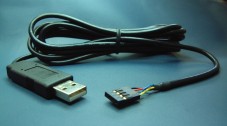|

USB has never been so easy
The AVIT Research USB to TTL Serial Cable is designed to allow simple rapid connection of microprocessors to the USB interface. It allows legacy products using PC serial ports to be easily upgraded to USB. The cable contains a USB to serial converter chip and is terminated in a standard 0.1” pitch header. The serial data is at standard TTL levels allowing it to interface directly to the micro-processor of the intended application.
-
Simple and Easy way to give USB support to your designs
-
Connects directly to microcontroller UART or I/O pins
-
PC communicates as a standard serial device
-
All circuitry integrated into sleek, moulded USB plug
-
Allows devices that previously used a MAX232 type level shifter to connect to a PC through a USB connector and appear as a standard COM port.
-
Compatible with legacy software.
-
Based on Silicon Labs CP2102
-
Cheap and simple way of upgrading existing products.
-
4-way connector (Gnd, RX, TX and +5v)
-
Supports data rates up to 921.6 kbaud allowing a significant performance increase over a standard serial port.
-
Allows devices to be powered from the USB port.
-
All I/O are protected from shorts and ESD.
-
Drivers Supplied by Silicon Labs
-
Can by customised for own branding (USB VID, PID, Descriptors etc.)

Software Drivers are available for Windows 98se, 2000, ME, XP, 2003, Vista (32/64bit), 7 (32/64bit), Linux, Max OS and WinCE. The drivers allow the USB device to appear as a standard serial port capable of baud rates up to 921600. This allows all windows programs to access the serial device exactly as if it were a built-in serial port. A DLL is also available for direct integration into software applications.
The USB to TTL Serial Cable also provides a 5 volt supply to the target system which can supply up to 50mA. This allows many embedded applications to be run without a separate power supply. The output is fully protected against short circuits.
3v3/5v TTL - The cables use 5v TTL logic levels but can be made 3v3 TTL Levels (if the 3v3 circuit is not 5v tolerant) by adding a 2.2k ohms resistor between Tx (Red wire) and ground. Note that the power pin will still supply +5v (as do the 3v3 FTDI cables).
Online Tutorial - Click here to see how to install, connect and communication from a microcontroller to PC using the USB to TTL cable.
Frequently Asked Questions - Click here to view the most frequently asked questions and their answers.
|
Wire |
Function |
FTDI cable equivalent |
|
Black |
Ground |
Black (pin 1) |
|
Red |
PC serial Tx (TTL Rx) |
Orange (pin 4) |
|
Blue |
PC serial Rx (TTL Tx) with 10k pull-up |
Yellow (pin 5) |
|
Yellow |
+5v |
Red (pin 3) |
|
Parameters |
Min |
Typ |
Max |
Units |
|
Serial port speed |
300 |
|
921600 |
baud |
|
Power output voltage* |
4.25 |
5.0 |
5.25 |
Volts |
|
Power output current |
|
|
50 |
mA |
|
Operating Temperature |
-40 |
|
+85 |
°C |
|
Input Voltage threshold (High) |
2.0 |
|
|
V |
|
Input Voltage threshold (Low) |
|
|
0.8 |
V |
|
Output high drive current |
|
|
8 |
mA |
|
Output low drive current |
|
|
-8 |
mA |
|
Mating Connector |
Harwin M20-9990405 or M20-9990406
Farnell 511-729 or 623-059 |
*Power supply voltage is dependant on the USB port to which the cable is connected. The minimum specified is the expected worst case when connected through a bus-powered hub that conforms to the USB specification |